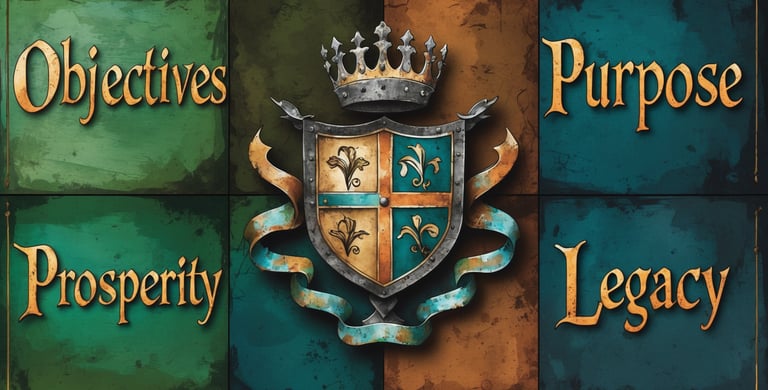Your Mission Statement as a Weapon
Crafting a Creed That Cuts Through Fog and Stands Under Fire
4FORTITUDEO - OBJECTIVES, PURPOSE, PROSPERITY, LEGACY
Your Mission Statement as a Weapon
Crafting a Creed That Cuts Through Fog and Stands Under Fire
“Write the vision; make it plain upon tablets, so he may run who reads it.”
— Habakkuk 2:2
A Mission Statement Is Not Corporate. It Is Covenant
Too many men have heard the phrase “mission statement” and rolled their eyes. They picture whiteboards, seminars, branding exercises, or clever taglines.
But that is not what we are after.
We are after something ancient.
A creed of alignment. A sword of remembrance.
Something that reminds you who you are when the storm hits and the world forgets.
The true mission statement is not for display. It is for war.
It must be clear enough to guide you in fog.
Strong enough to stand when every plan collapses.
Short enough to speak aloud.
Long enough to make your spine straighten when you do.
Why Most Men Don’t Have One (and What It Costs Them)
The average man drifts not because he’s lazy, but because he has no singular articulation of what he’s for.
Instead, he improvises.
He changes tone with audience.
He shifts direction with season.
He builds systems with no skeleton.
The result?
Activity without architecture.
Passion without posture.
Strength without structure.
The man without a written mission statement is at the mercy of every mood, offer, platform, and failure.
The Qualities of a Weaponized Creed
Not every sentence qualifies. A true mission statement must meet these five criteria:
Clear – No jargon. No filler. No poetry. It must mean something to your household, not just your LinkedIn.
Consecrated – It must answer to God. If it doesn’t bow to something higher than yourself, it will eventually serve your ego.
Costly – You must be willing to suffer for it. If not, it is not yet your creed. It’s just your comfort zone written in cursive.
Commanding – It must order your day, your time, your relationships, and your decisions. It governs. It isn’t optional.
Memorable – You must be able to speak it aloud—so your children, your friends, and your adversaries all know where you stand.
Examples of Unweaponized vs. Weaponized Creeds
Flimsy:
“I help others reach their full potential.”
→ This is vague, self-serving, and generic.
Weaponized:
“I train my sons and disciple my brothers to become righteous men of consequence when the world bows to chaos.”
→ This defines audience, standard, opposition, and alignment.
Flimsy:
“I pursue excellence in all I do.”
→ This is self-referential, non-specific, and cannot be measured.
Weaponized:
“I build a household that fears God, resists decay, and prepares warriors for the age to come.”
→ This says who, what, and why—with weight.
Tactical Construction: How to Forge Your Mission Statement
Step 1: Clarify Your Allegiance
Who or what do you ultimately serve?
This must be the beginning of your creed, even if not in words.
Step 2: Define Your Sphere of Responsibility
Who are you called to shape, protect, build, or lead?
Your wife? Sons? Community? Men? Culture?
Step 3: Name the Conflict
What evil are you resisting? What decay are you standing against? What chaos must your life restrain?
Step 4: Write the Sentence
Use this structure if needed:
“I [action verb] [your people] to [result], in order to [sacred impact].”
Examples:
“I train fathers to rebuild their families on covenant, honor, and generational order.”
“I steward my strength to provide, protect, and instruct the righteous in an age of collapse.”
“I speak, write, and labor so my sons inherit clarity in a time of confusion.”
Write. Edit. Say it aloud. And once it feels like steel, engrave it into your day.
Tactical Uses of the Statement
Morning Recitation
Speak it aloud—like a vow—before your day begins.
Not for inspiration, but for alignment.
Decision Filter
Use it to say no. If a request, opportunity, or plan doesn’t reinforce your creed, it is likely a distraction in uniform.
Family Teaching Tool
Let your sons hear it. Let them see it reflected in your time. Let your household know: this is what our name stands for.
Counterperspectives and Response
Objection: This feels like unnecessary pressure.
Response: Then you do not yet grasp the weight of your hours. This isn’t about pressure. It’s about posture. You are already living under a creed—it’s just unspoken, unmeasured, and likely unaligned.
Objection: But my life has many facets—I can’t reduce it to one sentence.
Response: You don’t have to reduce. You have to clarify. A creed doesn’t replace the complexity—it orders it.
Objection: I’m still figuring out my purpose.
Response: That’s what this is for. You don’t clarify purpose through daydreaming—you clarify it by declaring your standard and walking into the fire.
Wisdom and Warning
If you do not write your creed:
You will say yes to things you should have destroyed.
You will teach your children that alignment is optional.
You will drift toward productivity and call it faithfulness.
If you do:
You will walk with weight.
You will endure storms.
You will become a reference point—not a reaction, but a ruler in the moral geometry of your world.
A man with a creed is dangerous to systems of decay. Because he cannot be bought, distracted, or bent.
Final Charge
Write the sentence. Bleed over it. Rewrite it until it burns.
Then tattoo it into your days—not with ink, but with time, sacrifice, and consistency.
Let no morning begin without its memory.
Let no compromise survive its scrutiny.
Let no man in your house wonder what you live for.
Your creed is not a brand. It is the blade by which you cut paths for others to follow when the fog sets in.
Irreducible Sentence
If your creed cannot be spoken in the dark, it will not survive the fire.


